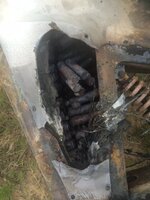To clarify, I believe that a well built pack based on high quality Li-Ion cells will be reasonably safe. However, "well built" means different things to different people. Industry standards are still in infant stages and governmental regulations (other than for transportation) seem to be focused on the "cell" level right now.
On the other hand, there has been significant studies done to analyze how a single cell failure (internal short) leads to a total thermal runaway (TR) situation and how this process can be stopped or at least mitigated. There's a handful of mechanical "dos and don't dos" that have filtered down from these studies and engineers building battery packs can pick and choose which ones to incorporate based on the application and other constraints. There are other "electronic" related failsafe's as well, like monitoring cell temperatures, but anything electronic can fail as well, so that's a slippery slope.
From my study of the Alta pack, they did a pretty good job mechanically.
The cells are well supported by a strong and relatively stiff thermally insulative honeycomb material which in turn is bolted in nine locations to the main housing. This is significant in several ways. The strength is needed to prevent migration of individual cells during the high loads and shock generated by offroad riding. Although this seems obvious, you'd be surprised how many DIY builders continue to simply "stuff" housings with little to no cell support. A failure waiting to happen. Each cell is held tight within it's respective honeycomb by tiny molded in tabs which allow a small airgap between the cell and the honeycomb walls. The airgap, along with the insulative properties of the honeycomb material, present a high thermal resistance path between adjacent cells and is intended to halt or at least slow the propagation of heat should one cell decide to go ballistic thus preventing a TR condition. In addition, the airgap is small enough to allow the honeycomb walls to support a bulging cell and therefore the most common catastrophic failure, a side rupture, can be prevented or contained. In the event of a side or bottom cell rupture or emergency venting (due to high temps/internal pressure), the ejected gasses and cell material can vent out the same airspace towards the PCB instead of towards an adjacent cell.
Besides the obvious, The passive thermal management system also increases safety as each cells negative end is thermally (but non-conductively) bonded to the modules aluminum heatsink, which in turn is thermally connected to the large main housing via some paste TIM. The extra heat capacity created will tend to draw any heat from a single cell, hopefully enough to prevent a single cell event from going TR.
While it can't prevent an internally generated single cell event, the incorporated fuse wires should prevent one shorted cell from causing the other cells in that P-group from shorting as well, causing a potential TR. On the other hand, Alta's fuse wire can prevent the majority of "externally" related failures from causing a TR. That's good.
So, what can go wrong?
As mentioned, I believe Alta did a great job both preventing and mitigating potential pack TR conditions. However, as of today, no manufacture can claim a 100% defect free li-ion cell. Quality manufacturing, particularly with regards to cleanliness, is not without anomalies. A tiny spec of dirt or conductive material unintentionally incorporated inside a cell can cause a short, and these tend to be latent defects, not picked up during testing. Just age alone can lead to internal changes in structure that can cause internal shorts. So, there's always that possibility.
The "single sided" interconnect design that allows the passive thermal management system and PCB based BMS could be a source of problems if for some reason the electrically insulative bond between cells and heatsink fails or is compromised. If any two of the 21 P-groups (per module) negative ends somehow become electrically connected through the heatsink they'll be essentially "shorted". At this point the fuse wires should pop but who knows . . . .
While I applaud Alta's cell support design and module venting path they stopped short in a couple ways. First, while the failed cell module might be protected during venting, venting from one module can and will impinge on another module (center modules only) and the two safety covers would be of little help. Hot gasses and conductive material would spray all over the adjacent module/PCB and be reflected back onto itself, probably causing major damage to both. Finally, there's no way to relieve this internal pressure other than the small port meant for altitude pressure compensation. One cell venting would probably not be an issue, but I suspect something would need to give in the event of multiple cell venting.
Bottom line, while the probability of a Alta Battery Pack catching on fire is low, it's certainly not zero. I suspect if Alta had 10,000 units in service being used regularly instead of numbers/usage were experiencing, it might be a slightly different story. Time will tell.
So why don't we see more fires associated with Li-Ion? Well, most applications are simply not as demanding as with a competition motorcycle. The propensity for a single cell to go thermal is greatly affected by it's SOC. The more energy the cell contains, the more energy it can release in the form of heat if shorted or compromised. Some studies have suggested that under 50% SOC a typical 18650 cell simply doesn't have enough energy to cause the type of temperature rise required to cause a catastrophic failure. Unfortunately, we need every hundredth of a volt we can squeeze out of our cells to obtain the performance we demand. However, this does cause some thought about what voltages we store our bikes at and why most TR situations occur during the last stages of charging.
As far as gas vs battery and societal acceptance of risks associated with the former, I get it. However, my point was more from a product liability standpoint. If it could be proved that some gas car had a known defect that could cause the car to go up in flames, that mfg would be liable. The Ford Pinto is a perfect case in point. Li-Ion batteries are known to be problematic in terms of TR, so as a mfg you'd be liable right from the get-go. My point could be debated technically, but most jurists aren't engineers nor are most judges.





